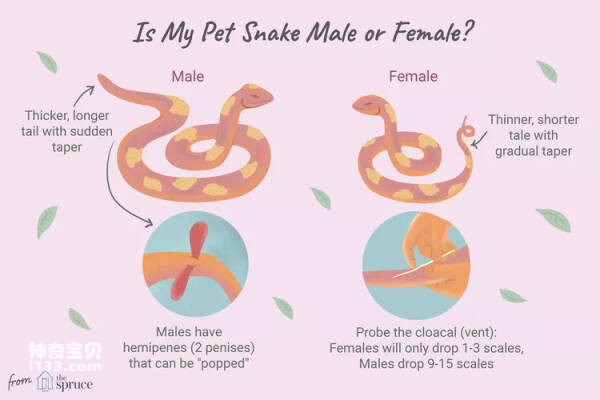Sometimes snake owners wonder how to tell the sex of a snake. The problem is, telling whether a snake is male or female isn't as simple as it is with many other animals. Physically, male and female snakes look similar. However, with a little experience, there are ways to tell the difference between the two.

The following methods of determining the sex of a snake should only be done by an experienced caretaker or veterinarian. If you are new to snakes and want to know the gender of your snake, find an experienced reptile keeper or veterinarian to show you these methods. If done incorrectly, the snake may be injured.
Tail features
Male snakes have a pair of tubular hemipenes (sex organs) usually located inside their bodies. They're basically two little penises kept safely inside the snake's tail. Female snakes have no hemipenis.
The hemipenis is located below the opening of the cloaca (exhaust port) and down the tail on either side of the snake's midline. Since these sexual organs are located inside the body of male snakes, they may not be obvious to you at first. There are clear clues that they are there, though. You can look at the shape and length of the tail to help you tell if your snake is a male.
The male's tail (the part of the snake that begins at the cloacal opening) is thicker and longer than the female's. It also tapers in different ways - starting out thicker and then suddenly thinning to the tip. The tail of a female snake is generally thinner and shorter than that of a male snake, and tapers evenly towards the tip.
While the differences can be quite dramatic when comparing snakes side by side, it can be difficult to determine the sex of a snake without a male and female to compare. That's why the following methods are more commonly used to accurately identify the sex of a snake than looking at tail characteristics.
Detection
Probing a snake involves inserting a thin metal rod (called a snake probe) into the snake's cloaca when the snake is awake. This special probe can be inserted further into a man's body because he has a hemipenis on either side of his vent. The probe will fall into one of these spaces pointing toward the tip of the tail.
When detecting female snakes, the probe will not drop too far into the vent. This is because when you point the probe toward the tip of the tail, it has no room to move. Females have only a small space for scent glands.
Imagine two long socks inside the tail of a male snake, flaring out at the snake's vent, and you're basically looking at a hemipenis. If the snake is male, the lubricated probe will slide into the vent toward the tail and into one of the hemipenes located on either side of the snake's tail.
If it is a female, the probe will drop only one to three scales on average.
If it's a male, it will drop an average of nine to fifteen scales. 1
Looking at the size of the detectors, the differences between the genders are quite significant. With larger snakes, the probe will actually fit into more pockets.
Snake detection should only be done if someone can hold the snake still, has an appropriately sized snake probe, and is confident that the detection is done carefully and correctly. You don't want to hurt your snake. If you are unsure how to perform this procedure safely, you should not attempt it.
Pop-up hemipenis
If you don't know what it means to "pop" a hemipenis, this term may scare you. Technically, this means temporarily returning them to their original shape so that they are visible on the outside of the tail (which is what happens with hemipenis prolapse). To do this, apply firm but gentle pressure with your fingers under the snake's vent, where the hemipenis will protrude. If done correctly, the hemipenis will pop out.
This method is usually only performed on smaller snakes such as ball pythons, and can be very traumatic if done incorrectly. This is not the preferred way to determine the sex of a snake because it is difficult to do. Also, you may not know if you just can't pop a hemipenis, or if the snake doesn't have a hemipenis (is a female).
animal tags:
We created this article in conjunction with AI technology, then made sure it was fact-checked and edited by a Animals Top editor.